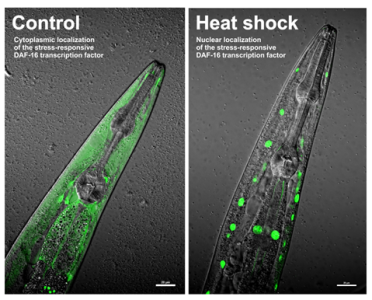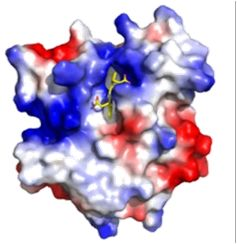Aging Physiology and Molecular Evolution
The Laboratory of Aging Physiology and Molecular Evolution focuses on the aging process and the function of globins in the nematode model Caenorhabditis elegans.
Aging
The process of aging is almost universal in the animal kingdom but the ultimate mechanism causing this deleterious process is still poorly understood. We exploit the advantages of the small, short-lived model Caenorhabditis elegans to study the molecular physiology of aging. Having a lifespan of only two to three weeks and a generation time of about 3 days, combined with its genetic amenability and the availability of an impressive molecular toolbox, this tiny nematode enables us to study the aging process in molecular detail, to a level inaccessible with most other species.
Young and old C. elegans adults. Above: first day of adulthood. Below: after two weeks of adulthood.
We are currently studying the physiology of worms that have a doubled lifespan due to two independent treatments: 1) mutation in the Insulin/IGF1-like signaling pathway and 2) axenic dietary restriction.
Insulin/IGF1-like Signaling

Axenic Dietary Restriction
Dietary restriction, the restriction of nutritional intake without causing malnutrition, has been known for long to extend lifespan in many animal species. In C. elegans, several regimens of dietary restriction have been tested and they extend worm lifespan to various degrees. The strongest lifespan effect is observed under axenic dietary restriction (ADR), a diet in which worms are withdrawn from their normal bacterial food source and survive and reproduce in a nutritious sterile culturing medium. In this medium, where worms cannot feed efficiently as they lack bacterial particles, lifespan is increased by 100% or more. The genetic underpinnings of this ADR effect are still enigmatic and many genes, known to be involved in other lifespan-extending treatments, seem not to be part of the ADR longevity program. However, we and others have identified that the genes cbp-1 and cup-4 are important players in ADR longevity and we are currently focusing on their mode of action.
Globins

In the genome of the nematode Caenorhabditis elegans, our group has discovered an unusually large family of 33 globins of which most have not been functionally characterized yet. The majority of these globins is expressed in specific sets of neurons and is probably involved in signaling. A subset of these globins is predicted to be tethered to the plasma membrane by acylation or with a transmembrane domain. We have recently characterized the function of GLB-12 in detail. This globin is expressed in the plasma membrane of several neurons and in the somatic gonad. In the latter tissue, it acts as a superoxide generator and operates in concert with intra- and extracellular superoxide dismutases to generate a hydrogen peroxide signal which in turn influences development and apoptosis levels in the underlying germ line. This way, GLB-12 acts in a signaling cascade that controls worm reproduction. Its function in the neurons is still unclear. Currently, GLB-1 and GLB-33 also receive our attention.
Contact information:
Ghent University, Biology Department
Laboratory of Aging Physiology and Molecular Evolution
K.L. Ledeganckstraat 35
9000 Gent
Belgium
phone: +32 (0)9 264 87 44
fax: +32 (0)9 264 87 93

